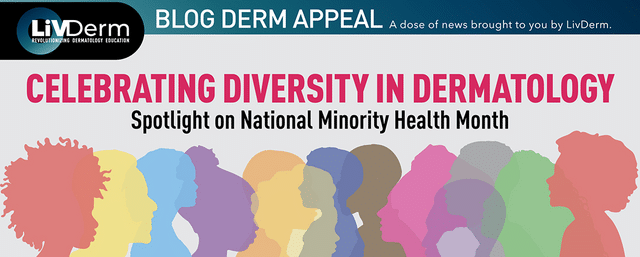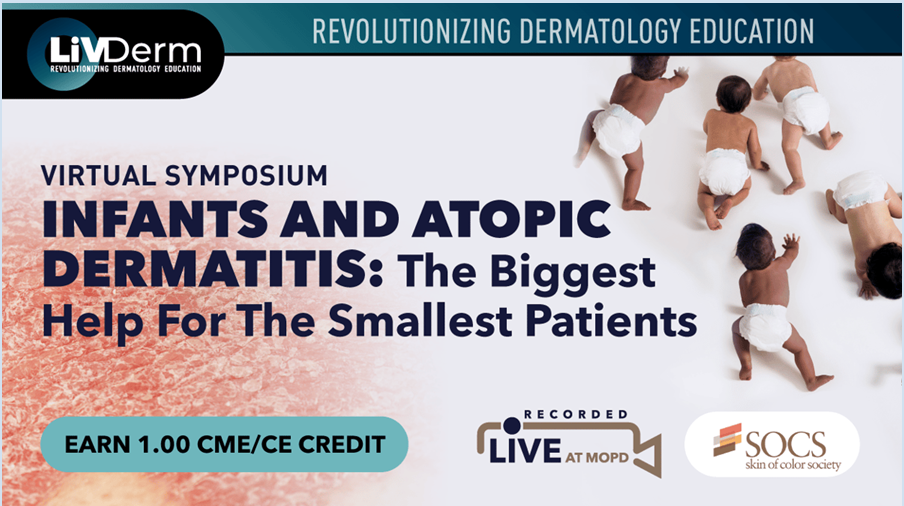April marks National Minority Health Month, a yearly observance where we recognize the ongoing health disparities that impact racial and ethnic minority populations. It is no secret that such disparities can largely affect overall health outcomes and access to care and therefore remains a significant issue in the field of dermatology, as well as other areas of health care.
National Minority Health Month highlights the importance of the continued efforts needed to promote equity in dermatological care to improve overall health outcomes for all, regardless of race or ethnicity. By bringing to light the unique dermatological concerns faced by minority communities, it is hoped we can address the existing barriers and work towards formulating diagnostic and treatment methods that embrace inclusivity, ultimately leading to more equitable and culturally competent care.
As projections suggest that by 2044, over half of the American population will be part of a minority group, it has become increasingly vital to establish such a framework of inclusivity and diversity within dermatology – a necessity crucial to all areas of health care.
The Key to Understanding Minority Health Disparities in Dermatology
In many instances, the terms “minority health” and “health disparities” are used interchangeably. For this reason, the National Institute of Minority Health and Health Disparities has developed two clear definitions for each of these as they state that “the two terms cover distinct areas of research with substantial overlap in areas where identification of or impact on a disparity is recognized.”
Minority Health: Distinctive health characteristics and attributes of racial and/or ethnic minority populations who are socially disadvantaged due in part to being subject to racist or discriminatory acts and are underserved in health care.
Health Disparity: A health disparity is a health difference that adversely affects disadvantaged populations in comparison to a reference population, based on one or more health outcomes. All populations with health disparities are socially disadvantaged due in part to being subject to racist or discriminatory acts and are underserved in health care.
In dermatology, the health disparities faced by many minority populations are evident in the disproportionate prevalence of skin diseases among them. Various studies have shown that certain conditions are indeed more prevalent among specific minority groups.
“Many skin diseases (e.g., acne vulgaris; eczematous dermatitis; infections caused by bacteria, fungi, or viruses) are common to most people of color–blacks, Asians, Hispanics/Latinos, and Native Americans. Diseases of more cosmetic concern (e.g., melasma, postinflammatory pigmentation, acne keloidalis nuchae, scalp and facial folliculitis, keloids, alopecias) occur more in skin of color than in white skin.” (Susan C. Taylor, MD, 2003).
In a study by Croce et al, it was found that atopic dermatitis (AD), one of the most common skin diseases, especially among children, is more commonly diagnosed in Black children, at a rate of approximately 1.7 to 2.1 more than white children.
Examining the statistics reveals a troubling picture, as evidenced by studies such as that conducted by Narla et al. It highlights concerning disparities, such as non-Hispanic Black individuals being diagnosed with conditions like melanoma at a later stage, which can significantly affect their health outcomes. “Moreover, the 5-year survival rate is 66% for non-Hispanic Black patients, compared with 90% for non-Hispanic Whites.”
The fact is that these disparities are attributed to many factors. This includes socioeconomic status, cultural differences and beliefs, limited access to dermatologic care, and even geographic location. Furthermore, many minority populations are often also faced with language barriers and a lack of health insurance, making their ability to seek treatment more challenging.
Existing Gaps
In addition to variations in the characteristics, manifestations, and presentations of certain skin diseases, minority health disparities also extend to other aspects of dermatological care.
Education & Training
As skin conditions present differently in different types of skin, having that level of knowledge to recognize these variations is essential when undergoing dermatology training.
One study by Lester, JC et al, found that 47% of dermatologists felt that their training was inadequate to diagnose skin disease in skin of color (SOC) patients. Another study which analyzed 4146 images from four general preclinical anatomy textbooks, found that “the skin tones represented 74.5% light, 21% medium, and 4.5% dark” – an overrepresentation of light skin tone and underrepresentation of dark skin tone.
This insufficient exposure to and lack of training in SOC dermatology during dermatology residency programs can impact the quality of care that is later provided to the patient and potentially lead to inaccurate, delayed, or even missed diagnoses.
Dermatology Workforce
Dermatologists from diverse backgrounds can bring invaluable cultural insights to their patients and practice. Through their own shared experiences and perspectives, it can foster greater communication and trust, leading to enhanced treatment approaches and patient adherence.
In a 2019 survey study evaluating the perceived barriers of minority medical students pursuing a career in dermatology, respondents also mentioned the following as major barriers; a lack of diversity, perceived negative perceptions of minority students by residencies, socioeconomic factors, and lack of mentors.
Research & Clinical Studies
An underrepresentation of minority groups in dermatologic research has also contributed to a lack of knowledge and education in certain areas. This could be for many reasons, including a lack of interest, limited access, distrust, non-recruitment, and many other factors.
A systematic review of 626 articles reporting randomized clinical trials (RCT) found that “52 of 626 international (11.3%) studies and 58 of 97 studies (59.8%) conducted exclusively within the United States reported on the racial or ethnic demographics of study participants.” Furthermore, taking into account all RCTs exclusively recruited within the United States that reported race, a total of 74.4% of the study participants were white.
Whatever the challenges, it’s clear that there is a pressing need for increased involvement of minority groups in clinical studies and research to enhance our understanding of skin diseases across diverse population groups.
Cultural Considerations
When it comes to treating patients from diverse backgrounds, cultural competency is essential. Not only recognizing, but also respecting the varying cultural beliefs and values can go a long way toward building trust and communication between the patient and provider. This can greatly impact patient outcomes and satisfaction as they are more likely to feel understood by their providers and more likely to adhere to specific treatment plans.
Promoting Diversity in Dermatology
Although historically, much of the past research and education in dermatology has largely focused on white populations, efforts are now being made to address the existing gaps and increase diversity within research programs and educational settings to help with the development of inclusive and equitable diagnostic and treatment approaches.
Many research institutions and associations have developed specific programs to highlight these existing disparities and work towards supporting the underrepresented minority groups in health care.
In 2021, the American Academy of Dermatology (AAD) put together a three-year plan to expand diversity, equity, and inclusion in dermatology. Their main goals included; to promote and facilitate diversity, equity, and inclusion within the AAD, to ensure dermatologic education and research encompasses health disparities and skin of color, and advocate for Black and Latino patient representation in research, to expand the Academy’s Advocacy Priorities to prioritize addressing health inequities, and to increase the number of practicing dermatologists who are underrepresented minorities and provide leadership and professional development programming.
The Skin of Color Society, the global leader in SOC dermatology, is dedicated to promoting awareness of and excellence in dermatology, which it does through research, education, mentorship, and advocacy. Established by Susan C. Taylor, MD, in 2004, the SOCS brings together the expertise and passion of dermatologists from diverse backgrounds to address the unique needs of patients with SOC.
The Pediatric Skin of Color Summit, hosted by the Masters of Pediatric Dermatology in partnership with the SOCS, took a deep dive into specific considerations and conditions in pediatric patients with SOC. Covering topics such as cultural sensitivity and hair and scalp disorders, and led by experts like Dr. Taylor, Lawrence A. Schachner, MD, Latanya T. Benjamin, MD, and many others, it provided the audience with a deeper understanding of caring for young patients with SOC and can be viewed here.
ProjectIMPACT, an initiative launched to help reduce racial disparities and bias in dermatology education and medical practice, is another such program. Together with VisualDX, renowned dermatologist and skin of color expert, Nada Elbuluk, MD, created this program to build a community of like-minded people who want to make a difference in health disparities and health equity. The website even boasts an image library of disease presentation in different skin colors.
Final Thoughts
By commemorating National Minority Health Month, we recognize the vital role that diversity plays in helping to advance the field of dermatology. Though the work is far from complete as health disparities continue to exist, leading to a breakdown in communication, access to treatment, and inclusivity, we must also celebrate the contributions of those dermatologists, researchers, and advocates who continue to champion initiatives. Their commitment remains a much-needed source of inspiration and progress in our ongoing efforts to promote health equity and inclusivity in dermatological care.
Useful Resources:
Sources:
- Reframing racial and ethnic disparities in atopic dermatitis in Black and Latinx populations
- Taylor SC. Epidemiology of skin diseases in people of color. Cutis. 2003 Apr;71(4):271-5. PMID: 12729089
- Narla S, Heath CR, Alexis A, Silverberg JI. Racial disparities in dermatology. Arch Dermatol Res. 2023 Jul;315(5):1215-1223. doi: 10.1007/s00403-022-02507-z. Epub 2022 Dec 12. PMID: 36508020; PMCID: PMC9743121
- https://skinofcolorsociety.org/
- https://www.visualdx.com/projectimpact/
- Disparities in Dermatology
- Projections of the Size and Composition of the U.S. Population: 2014 to 2060
- Diversity In Dermatology: Diversity Committee Approved Plan 2021-2023
- Louie P, Wilkes R. Representations of race and skin tone in medical textbook imagery. Soc Sci Med. 2018 Apr;202:38-42. doi: 10.1016/j.socscimed.2018.02.023. Epub 2018 Feb 23. PMID: 29501717
- Charrow A, Xia FD, Joyce C, Mostaghimi A. Diversity in Dermatology Clinical Trials: A Systematic Review. JAMA Dermatol. 2017 Feb 1;153(2):193-198. doi: 10.1001/jamadermatol.2016.4129. PMID: 28055072
- Soliman YS, Rzepecki AK, Guzman AK, Williams RF, Cohen SR, Ciocon D, Halverstam C. Understanding Perceived Barriers of Minority Medical Students Pursuing a Career in Dermatology. JAMA Dermatol. 2019 Feb 1;155(2):252-254. doi: 10.1001/jamadermatol.2018.4813. PMID: 30624570; PMCID: PMC6439537

















